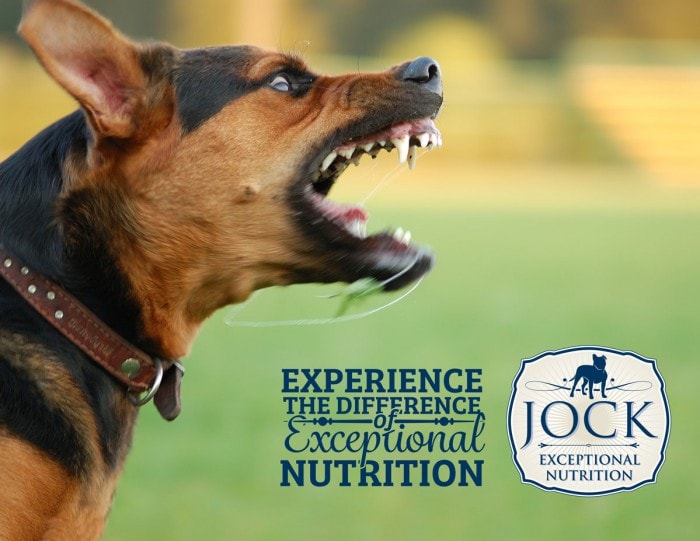Confronting an aggressive dog can be quite a frightening experience. Whether it’s your own dog or not, knowing how to handle yourself is key to making it out unscathed and helping you avoid similar incidents in the future. We spoke to our expert animal behaviourist, Lara Nobre for tips on handling aggressive dogs and what you can do to ensure your dog doesn’t develop aggressive behaviours.
The causes of dog aggression
Dog aggression has quite a number of causes. Lack of socialisation is a huge concern, which means the dog was not properly introduced to different people, children (and their behaviour), objects, etc. This may lead to it being uncomfortable in certain situations and react aggressively. Another common cause is frustration due to a lack of exercise, which can lead to bad behaviour. Lack of assertive leadership from the owner can also lead to the dog asserting its dominance and using violence to do so. Genetic breeding for aggression can also be a factor.
The warning signs
Growling is probably the most overt sign that a dog will display before attacking. The fact is that dogs give quite a number of warnings before attacking, but most of us just don’t recognise the signs.
Less well-known ones to look out for include the dog bowing its head and showing the whites of the eyes. Also look out for the hairs on their back standing up and pinned back ears. A yawn should also not be misread as casual, but rather that the dog is showing off its teeth. Sudden freezing when touched or intense eye contact are also signs to back off.
How to protect yourself from an attack
It is best to remain as calm as possible without yelling or physically attacking the dog, as sudden movements can trigger an attack. You should try to be confident and not appear weak to throw the dog off. Also, never turn your back to it (as this could trigger the dog’s prey drive and cause it to chase you), avoid eye contact and stand sideways to make yourself a smaller target.
It also helps to know which situations to avoid to prevent injury. A dog can become possessive over property – like a toy, food or territory – and even a human. Try not to become between the two. Dogs will also attack out of fear, because they don’t trust or feel comfortable in a situation. As a stranger or visitor, it is best to keep out of the way and let these dogs approach you. Dogs that are ill, old or in pain may also display aggressive behaviour. These dogs should be removed from potentially dangerous situations and a vet should be consulted to help heal the dog.
If you’re attacked
Should you be caught off guard by a dog attack, your initial reaction should be remaining very still and avoiding eye contact. You should then look for a way to create a barrier between the dog and yourself. If there’s a gate or door nearby, VERY VERY SLOWLY move towards it without any sudden movements. If there’s an object closer by (like a pillow, stick, dustbin, etc.), use this to keep the dog at a distance until you’re able to reach the barrier.
Should the dog attack, protect your face, chest and neck and keep your hands in fists to protect your fingers. If a bite is inevitable, try to keep it to your shins or forearms and don’t pull away to avoid your flesh from tearing. If the dog has a collar, grab it tightly and twist it to choke the dog and force it to release for air. If there’s no collar, very firmly grab the dog by the back of the neck, just under the occiput (sharp bone that protrudes slightly between the ears). This will allow you to control the dog and pull it away once it releases for another bite. If done correctly, the dog will also be unable to bite the hand holding it.
How to protect your dog from an attack
Always carry a large stick when taking your dog for a walk, so you can protect yourself and your dog from attacking dogs. You can also use pepper spray to deter an attack or use a fog horn to scare the attacking dog off (dogs are very sensitive to sound).
Stopping aggressive behaviour in your dog
Dogs, like children, need boundaries and discipline. To keep your own dog from developing aggressive behaviours, it is important to be an assertive pack leader, and to train and socialise it properly. Training is especially important for big to large breeds, and crucial for powerful breeds like Pit Bulls, Mastiffs or Rottweilers.
You should also exercise and play with your dog on a regular basis to enforce the human-dog bond and get rid of excess energy. Aggressive games, like wrestling or tug of war, should be avoided if you can’t ensure a win (the pack leader always wins, which reinforces their standing in the pack). You can also speak to your vet about having your dog spayed or neutered to reduce aggression.
It is important to remember that with exercise, stimulation, training, proper socialising, discipline, boundaries and love, most dogs have the potential to be great additions to a good family. Owners just have to put in the work to help get them there.


